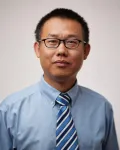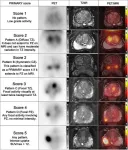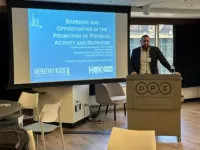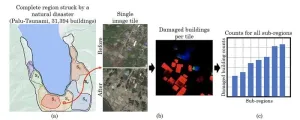(Press-News.org)
WASHINGTON (April 11, 2024) – Vosoritide’s first global phase 2 study showed an average increased growth rate of 1.8 cm per year in children with hypochondroplasia, a genetic cause of short stature in children, according to researchers from Children’s National Hospital.
“This is the first medicine that has been developed to specifically target the pathway involved in hypochondroplasia,” says Andrew Dauber, M.D., chief of Endocrinology at Children’s National. “These findings will help inform future studies of vosoritide for addressing growth disorders.”
This clinical trial funded by BioMarin is the first-of-its-kind to treat children with genetic short stature who do not have achondroplasia.
The team found the annualized growth velocity increased by 2.26 standard deviation (SD) and the height standard deviation score (SDS) increased by 0.36 SD during the treatment period versus the observation period. Hypochondroplasia specific height SDS increased by 0.38 SD, according to the trial published in eClinicalMedicine.
The authors studied 24 children with hypochondroplasia. Half were female and 22 out of 24 had the p.Asn540Lys variant in the fibroblast growth factor receptor 3 (FGFR3) gene. The mean age was 5.86 years old, and the baseline height was between -4.78 SD to -2.27 SD. The trial consisted of a 6-month observation period to establish a baseline annualized growth velocity followed by a 12-month intervention period during which vosoritide was administered daily via subcutaneous injection at a dose of 15 micrograms/kg/day.
The researchers found the absolute annualized growth velocity increased from a mean of 5.12 +/- 1.36 cm/year during the observation period to 6.93 +/- 0.93 cm/year during the intervention period for a mean difference of 1.81 cm/year for children with this condition. During the trial, the researchers also noted there were no treatment-related serious adverse events and no one discontinued therapy.
The study findings also showed standing height SDS increased by 0.37 SD during the year of treatment or 0.41 SD using hypochondroplasia specific growth charts.
Other growth-related conditions included in this phase 2 trial were Noonan syndrome, Neurofibromatosis type 1, Costello syndrome, NPR2 mutations and Aggrecan mutations. This manuscript includes only information specific to hypochondroplasia. Full data for all conditions studied in the trial will be available at a later date.
“Patients have come from all over the world to be part of our trial,” Dr. Dauber says. “We’re excited to see how well tolerated the medication was and how some patients had excellent responses.”
Media contact: Beth Riggs | briggs@childrensnational.org
###
About Children’s National Hospital
Children’s National Hospital, based in Washington, D.C., was established in 1870 to help every child grow up stronger.Today, it is the No. 5 children’s hospital in the nation and ranked in all specialties evaluated by U.S. News & World Report. Children’s National is transforming pediatric medicine for all children. The Children’s National Research & Innovation Campus opened in 2021, a first-of-its-kind pediatric hub dedicated to developing new and better ways to care for kids. Children’s National has been designated three times in a row as a Magnet® hospital, demonstrating the highest standards of nursing and patient care delivery. This pediatric academic health system offers expert care through a convenient, community-based primary care network and specialty care locations in the D.C. metropolitan area, including Maryland and Virginia. Children’s National is home to the Children’s National Research Institute and Sheikh Zayed Institute for Pediatric Surgical Innovation. It is recognized for its expertise and innovation in pediatric care and as a strong voice for children through advocacy at the local, regional and national levels. As a non-profit, Children's National relies on generous donors to help ensure that every child receives the care they need.
For more information, follow us on Facebook, Instagram, Twitter and LinkedIn.
END
Inside the brains of people with psychosis, two key systems are malfunctioning: a "filter" that directs attention toward important external events and internal thoughts, and a "predictor" composed of pathways that anticipate rewards.
Dysfunction of these systems makes it difficult to know what’s real, manifesting as hallucinations and delusions.
The findings come from a Stanford Medicine-led study, publishing April 11 in Molecular Psychiatry, that used brain scan data from children, teens and young adults with psychosis. The results confirm ...
Megan Reiter, an assistant professor of physics and astronomy at Rice University, has won a National Science Foundation (NSF) CAREER Award to investigate the influence of neighboring stars on the formation of planets.
The research funded by Reiter’s five-year, $951,446 NSF grant will shed light on a phenomenon that could significantly impact our understanding of how planets are born.
“By exploring the intricate interplay between stars, planets and their environments, we hope to clarify the key forces that shape planet formation,” Reiter said.
Observations show planets form in the ...
Join the International Society of Stem Cell Research (ISSCR) to celebrate Earth Day on 22 April 2024 by diving into the science of conservation, where the potential of stem cells is harnessed to foster a more sustainable and biodiverse future. This enlightening webinar co-hosted by Ashlee Hutchinson and Jun Wu will spotlight the revolutionary intersection of induced pluripotent stem cells (iPSCs), embryo models and genome engineering technologies with the noble cause of species preservation.
As our planet faces unprecedented biodiversity loss, this program will unveil how cutting-edge scientific advancements offer a lifeline for endangered species, ...
NORMAN, OKLA. – Hanping Ding, Ph.D., an assistant professor in the School of Aerospace and Mechanical Engineering at the University of Oklahoma, has been awarded a $3.1 million grant from the Hydrogen and Fuel Cell Technologies Office in the Department of Energy through the Bipartisan Infrastructure Law to further research in clean hydrogen production. The funding is part of a $750 million effort in President Biden’s Investing in American agenda. The money from the Department of Energy will go to 52 projects across 24 states to position the United States as a global leader in the clean hydrogen industry.
The combined outcomes of the 52 projects should allow the ...
Professor dr. Linda Amaral-Zettler, Research Leader at NIOZ Royal Netherlands Institute of Sea Research and the Chair in Marine Microbiology at the University of Amsterdam has been awarded a prestigious Advanced ERC-grant by the European Commission today. Amaral-Zettler receives almost 3,5 million euros for her research into biodegradation in the marine environment. “Biodegradable sounds really nice”, she admits. “But before we repeat the mistakes we’ve made with fossil-fuel-based plastics back in the last millenium, we really want to understand how these materials interact with marine life and how long they last in the environment.” “Biodegradable ...
We depend on our cells being able to divide and multiply, whether it’s to replace sunburnt skin or replenish our blood supply and recover from injury. Chromosomes, which carry all of our genetic instructions, must be copied in a complete way during cell division. Telomeres, which cap the ends of chromosomes, play a critical role in this cell-renewal process—with a direct bearing on health and disease.
The enzyme telomerase plays a key role in maintaining the length of telomeres as chromosomes replicate during ...
Modern biology textbooks assert that only bacteria can take nitrogen from the atmosphere and convert it into a form that is usable for life. Plants that fix nitrogen, such as legumes, do so by harboring symbiotic bacteria in root nodules. But a recent discovery upends that rule.
In two recent papers, an international team of scientists describe the first known nitrogen-fixing organelle within a eukaryotic cell. The organelle is the fourth example in history of primary endosymbiosis — the process by which a prokaryotic cell is engulfed by a eukaryotic cell and evolves beyond symbiosis into an organelle.
“It’s very rare that organelles ...
Reston, VA—PET/MRI can improve diagnostic accuracy for prostate cancer patients and help avoid unnecessary biopsies, according to new research published in the April issue of The Journal of Nuclear Medicine. By applying the PRIMARY scoring system to PET/MRI results, researchers found that more than 80 percent of unnecessary biopsies could be avoided at the expense of missing one in eight clinically significant prostate cancer cases.
The Prostate Imaging Reporting and Data System (PI-RADS) is a five-point ...
The concept of “One Health” – which emphasizes the relationship between human, animal, plant and environmental health – has been gaining ground in scientific discussions in recent years. Brazilian and North American researchers developing research using this approach presented their work on Tuesday (April 9th), in Chicago (United States), during FAPESP Week Illinois.
One of the panelists was Eduardo Esteban Bustamante, a professor at the University of Illinois in Chicago. He talked about behavioral interventions that have been tested to promote physical activity and healthy eating – practices that, according to the researcher, ...
AMHERST, Mass. – A team of computer scientists at the University of Massachusetts Amherst working on two different problems—how to quickly detect damaged buildings in crisis zones and how to accurately estimate the size of bird flocks—recently announced an AI framework that can do both. The framework, called DISCount, blends the speed and massive data-crunching power of artificial intelligence with the reliability of human analysis to quickly deliver reliable estimates that can quickly pinpoint and count specific features from very large collections ...






